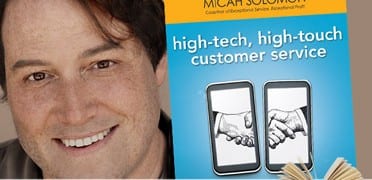To build customer loyalty, start by making a decision:
Are you willing to put the customer at the center of everything you do: at the center of your company or department, your daily routines, the way you hire, the way you design your webforms?
Don’t say “yes” too automatically. Putting the customer at the center is a more complicated, subtle, and arduous adventure than it sounds. But it’s worth it: At each successfully customer service-oriented company where I’ve bought stuff, worked as a consultant, or used as a customer loyalty case study in books or as a keynote speaker, somebody (or some somebodies) has made this decision.
If you’re willing to make this decision as well, we can get down to business.
Once you’ve made the decision
Just how do you go about putting the customer at the center of your operation? Waving your hands around, chanting “oh holy customer, thou art at the center of my universe” isn’t going to be sufficient, or advisable. What you need is to appropriately direct your resources and your employees to a framework that can dependably, repeatably satisfy your customers.
The framework for building satisfied customers
Do this by making sure you’ve covered the four elements of a satisfactory customer experience.
1. A “perfect” product or service
”¦perfect being defined as “designed and tested to perform perfectly within circumstances you can reasonably foresee.” (Not the snowstorm of the century, not the city-wide lockdown in Boston during the marathon terror manhunt. But reasonably foreseeable.)
2. Caring delivery
”¦no product is perfect in if it’s presented to the customer in a way that doesn’t appear to be “caring” to the intended recipient. No matter how delicious the food, no matter how safe the jet travel, if it’s presented in a way that doesn’t show care for the customer, it’s not going to be a hit.
3. Timely delivery
”¦a perfect product or service, delivered on a timetable that doesn’t match your customer’s expectations, is a defect. And customer expectations in the area of time have recently ramped up astoundingly. Factors that range from amazon.com to the smartphone revolution to global competition to customers with complicated work schedules have led to a ramping up of what customers expect in terms of timeliness in nearly industry.
4. An effective problem resolution process
”¦because you will, sometimes, be late/uncaring/imperfect. An effective and complete problem resolution process includes documentation and other oft-overlooked steps, but most importantly starts with an emotionally resonant apology–what I notoriously refer to as the “Italian Mama Method” of comforting a customer.
===
Beyond satisfaction: building brand ambassadors
A satisfactory product or service, delivered successfully time after time, is a lot of work to pull off. Worse, nobody ever shouted “Yeehaw, that was a really satisfactory experience I just had with your company.” It’s nothing to holler about or to jump on to Twitter to describe. To bring your service up to the level beyond satisfaction, where customers are engaged, loyal, advocating for you, requires something else. What I call “homebuilding.”¨ as in, you’re creating an environment/product/process/service that “feels like home” to your customer.
Now, if you think about it, customers don’t actually want the place they do business with to “be like home”– dirty dishes in the sink, deferred maintenance up the yin yang. So I use this “home” term advisedly and with some apprehension. What I mean by “like home” is what Horst Schulze meant by “like home” when he created the Ritz-Carlton brand: an experience that is like being a kid in the home of a caring parent: your preferences are attended to (there’s food in the fridge that is to your taste), you’re missed when you leave and sincerely welcomed back when you return, the maintenance is done without you even noticing. This is what “just like home” means to a customer and what can turn a customer into a loyalist and ambassador for your brand.
There’s a lot involved in creating a true loyalty-building, “homelike” situation for your customers, and I’ll be exploring it over the course of these posts. But I hope the homebuilding metaphor will give you a place to start: When you conclude an interaction with your customer, let her know that it matters to you that she come back soon (I’m assuming here that you’re not a surgeon or an undertaker). And when that customer returns from an extended absence, let her know that she’s been missed. Most of all, work on fulfilling, in that great phrase of The Ritz-Carlton, “even the unexpressed wishes” of your customers. Customers shouldn’t have to draw you a diagram to get across what they want from you. Figure it out yourself. It’ll be worth it.
============
Micah Solomon is a business keynote speaker, author, and customer service consultant. Micah offers keynote speaking and consulting on customer service issues, the customer experience, and company culture ”” and how they fit into today’s marketing and technology landscape. See Micah in action ”” including video and free resources ”” at https://micahsolomon.com. Or, click here for your own free chapter of Micah’s latest bestseller, High-Tech, High-Touch Customer Service (AMACOM Books).
””””””””””””””””””””””””””””””””””””””–



